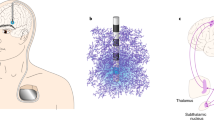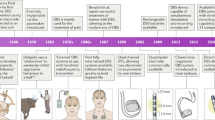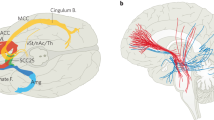Abstract
Over the past two decades, deep brain stimulation (DBS) has supplanted lesioning techniques for the treatment of movement disorders, and has been shown to be safe and efficacious. The primary therapeutic indications for DBS are essential tremor, dystonia and Parkinson's disease. In the case of Parkinson's disease, DBS is effective for treating the primary symptoms—tremor, bradykinesia and rigidity—as well as the motor complications of drug treatment. Progress has been made in understanding the effects of stimulation at the neuronal level, and this knowledge should eventually improve the effectiveness of this therapy. Preliminary studies also indicate that DBS might be used to treat Tourette's syndrome, obsessive-compulsive disorder, depression and epilepsy. As we will discuss in this review, the success of DBS depends on an appropriate rationale for the procedure, and on collaborations between neurologists and neurosurgeons in defining outcomes.
Key Points
-
In the 1950s, surgeons noted that stimulation used to localize thalamic targets to be lesioned for the relief of pain also improved the symptoms of movement disorders
-
Deep brain stimulation (DBS) is currently used to treat Parkinson's disease, essential tremor and dystonia, and patients with psychiatric disorders might also benefit from DBS therapy
-
A multidisciplinary team is required for evaluation and clinical decision-making in patients with movement disorders who are being considered for surgery
-
The neural elements that are most excitable in response to externally applied electric fields are the myelinated axons
-
Preoperative planning and target localization by most clinical teams currently relies on MRI localization, and microelectrode recording has an important role in improving the accuracy of targeting in stereotactic placement procedures
-
The long-term improvement and development of DBS will depend on our ability to understand its mechanism of action
This is a preview of subscription content, access via your institution
Access options
Subscribe to this journal
Receive 12 print issues and online access
$209.00 per year
only $17.42 per issue
Buy this article
- Purchase on Springer Link
- Instant access to full article PDF
Prices may be subject to local taxes which are calculated during checkout





Similar content being viewed by others
References
Pool JL et al. (1956) Hypothalamic–hypophysial dysfunction in man. Laboratory and clinical assessment. In Hypothalamic–Hypophysial Interrelationships, 114–124 (Eds Fields WS et al.) Springfield: Charles C Thomas
Hosobuchi Y et al. (1975) Chronic thalamic and internal capsule stimulation for the control of central pain. Surg Neurol 4: 91–92
Mazars G et al. (1973) Intermittent analgesic thalamic stimulation: preliminary note. Rev Neurol (Paris) 128: 273–279
Tasker RR et al. (1982) The Thalamus and Midbrain in Man: a Physiologic Atlas Using Electrical Stimulation. Springfield: Charles C Thomas
Hassler R (1955) The influence of stimulations and coagulations in the human thalamus on the tremor at rest and its physiopathologic mechanism. Proceedings of the Second International Congress of Neuropathology 2: 637–642
Merienne L and Mazars G (1982) Treatment of various dyskinesias by intermittent thalamic stimulation. Neurochirurgie 28: 201–206
Benabid AL et al. (1991) Long term suppression of tremor by chronic stimulation of the ventral intermediate thalamic nucleus. Lancet 337: 403–406
Siegfried J and Lippitz B (1994) Chronic electrical stimulation of the VL–VPL complex and of the pallidum in the treatment of movement disorders: personal experience since 1982. Stereotact Funct Neurosurg 62: 71–75
Benabid AL et al. (1994) Acute and long-term effects of subthalamic nucleus stimulation in Parkinson's disease. Stereotact Funct Neurosurg 62: 76–84
Siegfried J and Lippitz B (1994) Bilateral chronic electrostimulation of the ventroposterolateral pallidum: a new therapeutic approach for alleviating all parkinsonian symptoms. Neurosurg 35: 1126–1130
Schuurman PR et al. (2000) A comparison of continuous thalamic stimulation and thalamotomy for suppression of severe tremor. New Engl J Med 342: 461–468
Koller WC et al. (2001) Long-term safety and efficacy of unilateral deep brain stimulation of the thalamus in essential tremor. Mov Disord 16: 464–468
Sydow O et al. (2003) Multicentre European study of thalamic stimulation in essential tremor: a six year follow up. J Neurol Neurosurg Psychiatry 74: 1387–1391
Krack P et al. (2003) Five-year follow-up of bilateral stimulation of the subthalamic nucleus in advanced Parkinson's disease. N Engl J Med 349: 1925–1934
Kumar R et al. (2000) Deep brain stimulation of the globus pallidus pars interna in advanced Parkinson's disease. Neurology 55: S34–S39
Benabid AL et al. (1996) Chronic electrical stimulation of the ventralis intermedius nucleus of the thalamus as a treatment of movement disorders. J Neurosurg 84: 203–214
Fahn S and Elton RL (1987) UPDRS development committee: Unified Parkinson's Disease Rating Scale. In Recent Revelopments in Parkinson's Disease, 153–164 (Eds Fahn S et al.) Florham Park: MacMillan Health Care Information
Hosobuchi Y (1986) Subcortical electrical stimulation for control of intractable pain in humans: report of 122 cases (1970–1984). J Neurosurg 64: 543–553
Bendok B and Levy RM (1998) Brain stimulation for persistent pain management. In Textbook of Stereotactic and Functional Neurosurgery, 1539–1546 (Eds Gildenberg PL and Tasker RR) New York: McGraw-Hill
Beric A et al. (2001) Complications of deep brain stimulation surgery. Stereotact Funct Neurosurg 77: 73–78
Hariz MI (2002) Complications of deep brain stimulation surgery. Mov Disord 17 (Suppl 3): S162–S166
Vesper J et al. (2002) Dual channel deep brain stimulation system (Kinetra) for Parkinson's disease and essential tremor: a prospective multicentre open label clinical study. J Neurol Neurosurg Psychiatry 73: 275–280
Krauss JK et al. (2003) Chronic stimulation of the globus pallidus internus for treatment of non-dYT1 generalized dystonia and choreoathetosis: 2-year follow up. J Neurosurg 98: 785–792
DeLong MR (1990) Primate models of movement disorders of basal ganglia origin. Trends Neurosci 13: 281–285
Albin RL et al. (1989) The functional anatomy of basal ganglia disorders. Trends Neurosci 12: 366–375
Sambrook MA et al. (1988) The basal ganglia mechanisms mediating primate models of movement disorders. Current Problems in Neurology 9: 123–145
Ghika J et al. (1998) Efficiency and safety of bilateral contemporaneous pallidal stimulation (deep brain stimulation) in levodopa-responsive patients with Parkinson's disease with severe motor fluctuations: a 2-year follow-up review. J Neurosurg 89: 713–718
Loher TJ et al. (2002) Effect of chronic pallidal deep brain stimulation on off period dystonia and sensory symptoms in advanced Parkinson's disease. J Neurol Neurosurg Psychiatry 73: 395–399
Kumar R et al. (1998) Double-blind evaluation of subthalamic nucleus deep brain stimulation in advanced Parkinson's disease. Neurology 51: 850–855
Thobois S et al. (2002) Subthalamic nucleus stimulation in Parkinson's disease: clinical evaluation of 18 patients. J Neurol 249: 529–534
Anderson VC et al. (2005) Pallidal vs subthalamic nucleus deep brain stimulation in Parkinson disease. Arch Neurol 62: 554–560
Mazzone P et al. (2005) Implantation of human pedunculopontine nucleus: a safe and clinically relevant target in Parkinson's disease. Neuro Rep 16: 1877–1881
Plaha P and Gill S (2005) Bilateral deep brain stimulation of the pedunculopontine nucleus for Parkinson's disease. Neuro Rep 16: 1883–1887
Lenz FA et al. (1994) Single neuron analysis of the human ventral thalamic nuclear group: tremor-related activity in functionally identified cells. Brain 117: 531–543
Hua SE and Lenz FA (2005) Posture-related oscillations in human cerebellar thalamus in essential tremor are enabled by voluntary motor circuits. J Neurophysiol 93: 117–127.
Deuschl G et al. (2000) The pathophysiology of parkinsonian tremor: a review. J Neurol 247 (Suppl 5): V33–V48
Krack P et al. (1997) Stimulation of subthalamic nucleus alleviates tremor in Parkinson's disease. Lancet 350: 1675
Zesiewicz TA et al. (2005) Practice parameter: therapies for essential tremor: report of the Quality Standards Subcommittee of the American Academy of Neurology. Neurology 64: 2008–2020
Kumar R et al. (2003) Long-term follow-up of thalamic deep brain stimulation for essential and parkinsonian tremor. Neurology 61: 1601–1604
Lee JYK and Kondziolka D (2005) Thalamic deep brain stimulation for management of essential tremor. J Neurosurg 103: 400–403
Kleiner-Fisman G et al. (2003) Long-term follow up of bilateral deep brain stimulation of the subthalamic nucleus in patients with advanced Parkinson disease. J Neurosurg 99: 489–495
Stover NP et al. (2005) Stimulation of the subthalamic nucleus in a patient with Parkinson disease and essential tremor. Arch Neurol 62: 141–143
Chou KL et al. (2005) Bilateral subthalamic nucleus deep brain stimulation in a patient with cervical dystonia and essential tremor. Mov Disord 20: 377–380
Murata J et al. (2003) Electrical stimulation of the posterior subthalamic area for the treatment of intractable proximal tremor. J Neurosurg 99: 708–715
Mohadjer M et al. (1990) Long term results of stereotaxy in the treatment of essential tremor. Stereo Funct Neurosurg 54: 125–129
Papavassiliou E et al. (2004) Thalamic deep brain stimulation for essential tremor: relation of lead location to outcome. Neurosurg 54: 1120–1129
Gross RE et al. (2004) Histological analysis of the location of effective thalamic stimulation for tremor: case report. J Neurosurg 100: 547–552
Lenz FA et al. (1999) Thalamic single neuron activity in patients with dystonia: dystonia-related activity and somatic sensory reorganization. J Neurophysiol 82: 2372–2392
Hallett M (1995) Is dystonia a sensory disorder? Ann Neurol 38: 139–140
Vidailhet M et al. (2005) Bilateral deep-brain stimulation of the globus pallidus in primary generalized dystonia. N Engl J Med 352: 459–467
Krauss JK et al. (2004) Deep brain stimulation for dystonia. J Clin Neurophysiol 21: 18–30
Fahn S et al. (1998) Classification of dystonia. Adv Neurol 78: 1–10
Eltahawy HA et al. (2004) Primary dystonia is more responsive than secondary dystonia to pallidal interventions: outcome after pallidotomy or pallidal deep brain stimulation. Neurosurg 54: 613–619
Krack P et al. (1999) From off-period dystonia to peak-dose chorea: the clinical spectrum of varying subthalamic nucleus activity. Brain 122: 1133–1146
Chou KL et al. (2005) Bilateral subthalamic nucleus deep brain stimulation in a patient with cervical dystonia and essential tremor. Mov Disord 20: 377–380
Mayberg HS et al. (2005) Deep brain stimulation for treatment-resistant depression. Neuron 45: 651–660
Nuttin BJ et al. (2003) Long-term electrical capsular stimulation in patients with obsessive-compulsive disorder. Neurosurg 52: 1263–1272
Anderson D and Ahmed A (2003) Treatment of patients with intractable obsessive-compulsive disorder with anterior capsular stimulation: case report. J Neurosurg 98: 1104–1108
Kopell BH et al. (2004) Deep brain stimulation for psychiatric disorders. J Clin Neurophysiol 21: 51–67
Visser-Vandewalle V et al. (2003) Chronic bilateral thalamic stimulation: a new therapeutic approach in intractable Tourette syndrome: report of three cases. J Neurosurg 99: 1094–1100
Hodaie M et al. (2002) Chronic anterior thalamus stimulation for intractable epilepsy. Epilepsia 43: 603–608
Oommen J et al. (2005) Experimental electrical stimulation therapy for epilepsy. Curr Treat Options Neurol 7: 261–271
Okun MS et al. (2005) Management of referred deep brain stimulation failures: a retrospective analysis from 2 movement disorders centres. Arch Neurol 62: 1250–1255
Saint-Cyr JA and Trepanier LL (2000) Neuropsychologic assessment of patients for movement disorder surgery. Mov Disord 15: 771–783
Finelli DA et al. (2002) MR imaging-related heating of deep brain stimulation electrodes: in vitro study. AJNR Am J Neuroradiol 23: 1795–1802
Alterman RL et al. (2004) Immediate and sustained relief of levodopa-induced dyskinesias after dorsal relocation of a deep brain stimulation lead: case report. Neurosurg Focus 17: E6
Kuncel AM and Grill WM (2004) Selection of stimulus parameters for deep brain stimulation. Clin Neurophysiol 115: 2431–2441
Kiss ZH et al. (2003) Neural substrates of microstimulation-evoked tingling: a chronaxie study in human somatosensory thalamus. Eur J Neurosci 18: 728–732
McIntyre CC et al. (2004) Electric field and stimulating influence generated by deep brain stimulation of the subthalamic nucleus. Clin Neurophysiol 115: 589–595
Ranck JB (1975) Which elements are excited in electrical stimulation of mammalian central nervous system: a review. Brain Res 98: 417–440
Durand DM (2003) Electric field effects in hyperexcitable neural tissue: a review. Radiat Prot Dosimetry 106: 325–331
Kiss ZH et al. (2003) Is the target for thalamic deep brain stimulation the same as for thalamotomy? Mov Disord 18: 1169–1175
Anderson T et al. (2004) Mechanisms of deep brain stimulation: an intracellular study in rat thalamus. J Physiol 559: 301–313
McIntyre CC et al. (2004) Uncovering the mechanism(s) of action of deep brain stimulation: activation, inhibition, or both. Clin Neurophysiol 115: 1239–1248
Dostrovsky JO et al. (2000) Microstimulation-induced inhibition of neuronal firing in human globus pallidus. J Neurophysiol 84: 570–574
Brown P et al. (2004) Effects of stimulation of the subthalamic area on oscillatory pallidal activity in Parkinson's disease. Exp Neurol 188: 480–490
Garonzik IM et al. (2002) Intraoperative microelectrode and semi-microelectrode recording during the physiological localization of the thalamic nucleus ventral intermediate. Mov Disord 17 (Suppl 3): S135–S144
Starr PA (2002) Placement of deep brain stimulators into the subthalamic nucleus or globus pallidus internus: technical approach. Stereotact Funct Neurosurg 79: 118–145
Schaltenbrand G and Walker AE (1982) Stereotaxy of the Human Brain. New York: Thieme-Stratton
Benabid AL et al. (2002) Imaging of subthalamic nucleus and ventralis intermedius of the thalamus. Mov Disord 17 (Suppl 3): S123–S129
Simon SL et al. (2005) Error analysis of MRI and Leksell stereotactic frame target localization in deep brain stimulation surgery. Stereotact Funct Neurosurg 83: 1–5
Hamid NA et al. (2005) Targeting the subthalamic nucleus for deep brain stimulation: technical approach and fusion of pre- and postoperative MR images to define accuracy of lead placement. J Neurol Neurosurg Psychiatry 76: 409–414
Lenz FA et al. (1988) Techniques for microstimulation and recordings of single units and evoked potentials during stereotactic surgery. J Neurosurg 68: 630–634
Vitek JL et al. (1998) Microelectrode-guided pallidotomy: technical approach and its application in medically intractable Parkinson's disease. J Neurosurg 88: 1027–1043
Hutchison WD et al. (1998) Neurophysiological identification of the subthalamic nucleus in surgery for Parkinson's disease. Ann Neurol 44: 622–628
Lenz FA et al. (1988) Single-unit analysis of the human ventral thalamic nuclear group: somatosensory responses. J Neurophysiol 59: 299–316
Garonzik IM et al. (2003) Microelectrode techniques: single cell and field potential recordings in the thalamus and basal ganglia. In Microelectrodes in Movement Disorder Surgery, 28–37 (Ed. Burchiel KJ) Stuttgart: Thieme
Cintas P et al. (2003) Deep brain stimulation for Parkinson's disease: correlation between intraoperative subthalamic nucleus neurophysiology and most effective contacts. Stereotact Funct Neurosurg 80: 108–113
McIntyre CC et al. (2004) How does deep brain stimulation work? Present understanding and future questions. J Clin Neurophysiol 21: 40–50
Benazzouz A et al. (2002) Intraoperative microrecordings of the subthalamic nucleus in Parkinson's disease. Mov Disord 17 (Suppl 3): S145–S149
Motta PS and Judy JW (2005) Multielectrode microprobes for deep-brain stimulation fabricated with a customizable 3-D electroplating process. IEEE Trans Biomed Eng 52: 923–933
Chen YY et al. (2004) A laser micromachined probe for recording multiple field potentials in the thalamus. J Neurosci Methods 139: 99–109
Hariz MI (2002) Safety and risk of microelectrode recording in surgery for movement disorders. Stereotact Funct Neurosurg 78: 146–157
Hamani C et al. (2005) Correspondence of microelectrode mapping with magnetic resonance imaging for subthalamic nucleus procedures. Surg Neurol 63: 249–253
Vitek JL (2002) Deep brain stimulation for Parkinson's disease: a critical re-evaluation of STN versus GPi DBS. Stereotact Funct Neurosurg 78: 119–131
Voon V et al. (2005) Psychiatric symptoms in patients with Parkinson disease presenting for deep brain stimulation surgery. J Neurosurg 103: 246–251
Jankovic J et al. (1995) Outcome after stereotactic thalamotomy for parkinsonian, essential and other types of tremor. Neurosurg 37: 680–687
Marsden CD and Parkes JD (1977) Success and problems of long-term levodopa therapy in parkinson's disease. Lancet 1: 345–349
Marsden CD (1994) Problems with long-term levodopa therapy for Parkinson's disease. Clin Neuropharmacol 17 (Suppl 2): S32–S44
Watts RL and Koller WC (1998) Movement Disorders. New York: McGraw-Hill
Fahn S et al. (1988) Clinical rating scale for tremor. In Parkinson's Disease and Movement Disorders, 225–234 (Eds Jankovic J and Tolosa E) Baltimore: Urban and Schwarzenberg
Starr PA et al. (1999) Magnetic resonance imaging-based stereotactic localization of the globus pallidus and subthalamic nucleus. Neurosurgery 44: 303–313
Author information
Authors and Affiliations
Corresponding author
Ethics declarations
Competing interests
The authors declare no competing financial interests.
Rights and permissions
About this article
Cite this article
Anderson, W., Lenz, F. Surgery Insight: deep brain stimulation for movement disorders. Nat Rev Neurol 2, 310–320 (2006). https://doi.org/10.1038/ncpneuro0193
Received:
Accepted:
Issue Date:
DOI: https://doi.org/10.1038/ncpneuro0193
This article is cited by
-
The Child & Youth CompreHensIve Longitudinal Database for Deep Brain Stimulation (CHILD-DBS)
Child's Nervous System (2021)
-
Targeting neuroplasticity in patients with neurodegenerative diseases using brain stimulation techniques
Translational Neurodegeneration (2020)
-
Implantable neurotechnologies: bidirectional neural interfaces—applications and VLSI circuit implementations
Medical & Biological Engineering & Computing (2016)
-
Deep brain stimulation for dystonia
Translational Neurodegeneration (2014)



